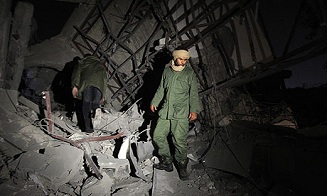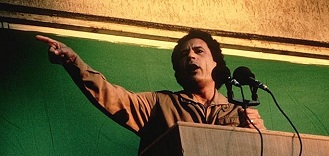US, NATO defend policy of targeting Gaddafi

Libyan soldiers near a damaged building at the Bab al-Aziziya
compound in Tripoli. Photograph: Mohamed Messara/EPA
The Obama administration and spokesmen for NATO have publicly defended the targeting of Libyan ruler Muammar Gaddafi through air strikes on his residential compound in Tripoli, the Libyan capital. NATO warplanes struck the residence on Monday and destroyed much of it, but the Libyan leader escaped the assassination attempt unhurt.
F-16 fighter-bombers operated by Norway carried out the attack. NATO said later that one of its F-16 jets had crash-landed at the Sigonella airbase in western Sicily after a mission over Tripoli. It was not clear whether this was one of the warplanes that bombed the Bab-al-Aziziyah compound where Gaddafi and his family live.
A Libyan government spokesman, Moussa Ibraham, denounced the air strike. “We are regarding it as an attempt to assassinate the leader and unifying figure of this country and other political leaders of this country,” he said at a news conference in front of the destroyed buildings, calling it an act “worthy of the mafia, of gangs, but not of governments.”
He asked, “How is this act of terrorism protecting civilians in Libya? How is this act of terrorism helping establish peace in Libya? Targeting political leaders will only help make the situation worse.”
The Libyan government also charged that NATO was blockading the port of Tripoli and preventing humanitarian supplies from entering, although a NATO spokesman denied that food, medicine and other relief supplies were being turned away.
White House press secretary Jay Carney denied the Libyan charge, claiming that it was “certainly not the policy of the coalition, of this administration, to decapitate, if you will, or to effect regime change in Libya by force.”
Defense Secretary Robert Gates, who met with his British counterpart Liam Fox Tuesday, said at a press conference afterwards that Libyan command centers were “legitimate targets. We are not targeting him specifically, but we do consider command and control targets to be legitimate targets wherever we find them.”
The Associated Press observed, in reporting this comment, that Gates was “suggesting that strongman Muammar Gaddafi himself is increasingly in danger.” While Gates claimed that NATO planes were not targeting Gaddafi specifically, but rather military command centers, the AP report pointed out, “That distinction is exceedingly thin, given that Gaddafi is commander in chief of government forces …”
In an effort to stretch the language of the UN Security Council resolution used by the US and NATO forces as the legal pretext for the war against Libya, Gates added, “Those centers are the ones that are commanding the forces that are committing some of these violations of humanitarian rights, such as in Misrata.”
British defense minister Fox added, in language that suggested open-ended military escalation, that he had been discussing with Gates and Admiral Michael Mullen, the chairman of the Joint Chiefs of Staff, how to “exploit emerging opportunities on the ground” in Libya. He said the deployment of US Predator drones was “a key contribution” that “has proven to be of immense value” in operations around Misrata, Libya’s third-largest city and the focal point of heavy fighting between Gaddafi’s troops and US/NATO-backed rebels.
In addition to the Predator drones, which are equipped with Hellfire missiles that can be fired by remote control whenever a target is identified, the Pentagon has also supplied NATO with a Global Hawk drone, which can fly far longer unarmed surveillance missions to direct bombing attacks.
Lt. Gen. Charles Bouchard, the Canadian commander of the NATO attack on Libya, sought to preserve the pretense that NATO was not seeking to kill Gaddafi, declaring, “This is about command-and-control nodes, and not about individuals.”
But an unnamed “senior NATO officer” told the Los Angeles Times Tuesday that the deployment of Predator drones and the renewed bombing of government targets in Tripoli “is a shift, absolutely,” whose aim was to target Gaddafi. “We’re picking up attacks on these command-and-control facilities. If he happens to be in one of those buildings, all the better.”
According to a report Wednesday in the New York Times, “President Obama had been briefed on the more energetic bombing campaign, which included a strike early on Monday on Colonel Qaddafi’s residential compound in the heart of Tripoli, the capital.”
The newspaper reported, “The NATO campaign, some officials said, arose in part from an analysis of Colonel Gaddafi’s reaction to the bombing of Tripoli that was ordered by President Ronald Reagan a quarter-century ago.” That attack (see “25 years ago—The first US attempt to murder Gaddafi” below) was a failed attempt to murder Gaddafi, although 37 Libyans were killed, including Gaddafi’s adopted daughter, an infant.
The Times also noted the wink-and-a-nod approach to the targeting of Gaddafi, citing comments from NATO officials: “Attacks on those hidden military posts are wholly legitimate, officials said—but there is always a chance that Colonel Gaddafi might be inside one of them.”
Russian Prime Minister Vladimir Putin publicly denounced the air strikes against Gaddafi’s residence during a press conference in Copenhagen, Denmark. He pointed to the contradictory statements from US and NATO officials about targeting the Libyan ruler: “They said they didn’t want to kill Gaddafi. Now some officials say, ‘Yes, we are trying to kill Gaddafi.’” Putin then asked: “Who permitted this? Was there any trial? Who took on the right to execute this man?”
Russia refrained from using its veto power to block the UN Security Council resolution on Libya, but Russian Foreign Minister Sergei Lavrov said that Moscow would not back a new resolution to expand the foreign intervention. No such resolution had been discussed, he claimed, adding, “if it leads to a further escalation of civil war through one method or another, including foreign intervention, we will not be able to support it.”
At the same time, the Obama administration took its first public steps toward direct aid to the anti-Gaddafi forces, modifying its sanctions on Libya to allow the Benghazi-based opposition forces to sell the oil they control on the world market, and to use the funds to buy weapons. The White House also officially approved spending up to $25 million in non-military supplies for the rebels.
British Prime Minister David Cameron has discussed supplying arms to the rebels in cabinet discussions, according to reports in the British press. One Tory MP said he had received a letter from Cameron confirming that Cameron and his cabinet “do not rule out supplying lethal equipment. But we have not taken a decision to do so and there remain legal and practical questions.”
Foreign secretary William Hague confirmed that there was no absolute ban on arms shipments to the rebels, declaring, “In certain circumstances, it is legal under the UN resolution to supply equipment to protect civilian life.” In other words, “protecting civilians” can become the pretext for whatever action the imperialist powers decide is necessary to accomplish their predatory goals in Libya.
A former Labour defense minister, Bob Ainsworth, called for intensifying the military onslaught against Libya, saying the Conservative-Liberal Democrat coalition government should escalate the war, making “enough effort now to bring it swiftly to a conclusion.”
In the United States, both Democrats and Republicans in the US Senate are negotiating the language for a joint resolution of support for the war in Libya. Under the War Powers Act, President Obama must obtain congressional authorization for the deployment of US military forces by May 20, or begin to withdraw them from combat operations.

As a veteran Middle East correspondent and former foreign editor, Patrick Martin has his finger on the pulse of one of the most volatile regions in the world.
His extensive travels and assignments in the Middle East began in 1971 as a 20-year-old, when he motorcycled across North Africa, and have included four years in the 1990s as The Globe and Mail’s Middle East bureau chief. Most recently, in 2004, he returned to Iraq to cover its handover to civilian authorities and its prospects for a peaceful future.
Across the region, Patrick has witnessed the resurgence of Islam as a political force and has written extensively of its role in emerging democracies.
___________________________________________________________________________________
Photo 1: http://www.guardian.co.uk/world/2011/apr/25/gaddafi-compound-hit-nato-attack?INTCMP=ILCNETTXT3487
Photo 2: http://www.smithsonianmag.com/history-archaeology/Ronald-Reagan-and-Moammar-Qadhafi.html
URL: http://www.a-w-i-p.com/index.php/2011/04/28/us-nato-defend-policy-of-targeting-gadda

























